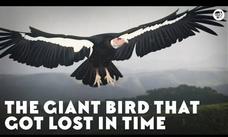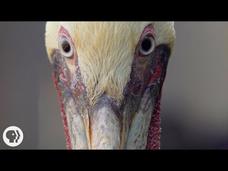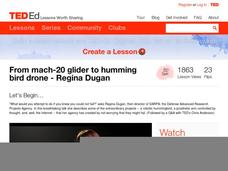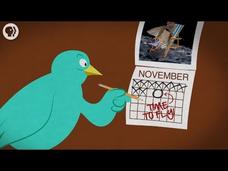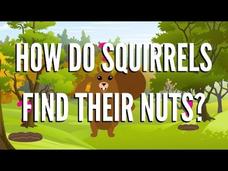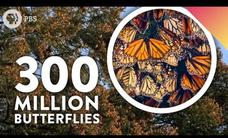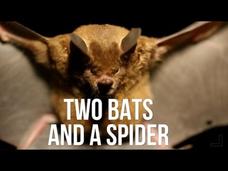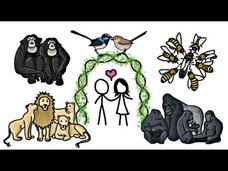PBS
The Giant Bird That Got Lost in Time
The California condor is the largest flying bird in North America and has been for a very long time. While perfectly equipped to survive in their time period, today there are fewer and fewer in existence. An episode of a larger series...
MinuteEarth
Birds that Hibernate in Lakes?!
Birds seem to disappear at various times of the year, and many early theories about this phenomenon turned out to be wrong. The video introduces two of these theories as well as how scientists learned the truth. It explains a few...
TED-Ed
Why Can't Some Birds Fly?
Back in the day, all birds had the ability to fly. Why would evolutionary adaptations take that away from some species? A video presentation discusses the cost of having the ability to fly and why that feature may not be ideal for some...
Deep Look
How Do Pelicans Survive Their Death-Defying Dives?
Get ready to take the plunge! Science scholars go fishing with a brown pelican and see how it can withstand the impact of the water from a height of 40 feet. The narrator shows the birds in action and describes the physical adaptations...
Deep Look
What Happens When You Put a Hummingbird in a Wind Tunnel?
Hummingbirds consume their weight in nectar every day. The video explains their unusual flying abilities. From holding their bodies perfectly still while flapping their wings in mid air in order to get the nectar to shaking off water...
TED-Ed
From Mach-20 Glider to Humming Bird Drone
"What would you attempt to do if you knew you could not fail?" This question guides Regina Dugan's exploration of amazing achievements in science and engineering that push the boundary of impossibility. From robotic hummingbirds and...
Be Smart
Where Do Birds Go In Winter?
The poet Homer believed that birds went to battle tribes of goat-riding dwarfs during the winter. As the video explains, this myth and many others that seem crazy to us now, wasn't questioned for many years. The reality isn't quite as...
PBS
The Biggest Thing That Ever Flew
Imagine a reptile the size of a giraffe that flies across oceans. This reptile, quetzalcoatlus, existed, and scientists continue to learn more about this fascinating creature. The video, part of the Eons series, explains where the...
Be Smart
How Do Squirrels Find Their Nuts?
Viewers of this short video learn how squirrels and birds not only find their stored nuts in winter but also distract would-be thieves. Viewers see that animals have the ability to take action today (burying nuts) to fulfill their future...
Be Smart
The Mystery of the World’s Greatest Butterfly Migration
Follow the migration of the monarch butterfly from northern North America to southern Mexico. A video explains how monarch butterflies navigate their migration north in the spring and south in the fall. Pupils learn how it takes multiple...
Deep Look
What Makes Owls So Quiet and So Deadly?
Known as excellent hunters, owls don't fly with the fast speeds of other birds of prey. The video focuses on the feathers and nocturnal habit of owls. With quiet, almost silent flight, owls sneak up on their prey.
Deep Look
Can A Thousand Tiny Swarming Robots Outsmart Nature?
Kilobots, made from only $15 worth of parts, work together to achieve a group goal. The video explains how with a few simple lines of programming, these tiny robots tackle tasks in much the same way animals or cells have for centuries....
The Brain Scoop
Two Bats and a Spider
What creatures lurk in the rainforest at night? Meet three of them in one short video. Part of a playlist exploring mammals, the video presents a look at night research in the Amazon. Scientists locate and photograph two bat species and...
Real Engineering
Area Rule: How to Make Planes Fly Faster
It's a bird, it's a plane, it's a modern aircraft with cross-sectional areas taken into consideration. A short video in the Real Engineering playlist describes how cross-sectional areas of airplanes relate to their speeds. It shows...
TED-Ed
The Surprising (And Invisible) Signatures of Sea Creatures
Airplanes resulted from observations of birds flying. What inventions could be inspired by watching sea creatures move? Viewers are challenged to consider how bio-observation might lead them to design something to overcome a challenge in...
Curated OER
Jurassic Fight Club: T-Rex vs. Raptors - Part 1/2
Fight or flight response and physical prowess is examined in this seven-minute video. Using evidence and a knowledge of animal behavior, scientists were able to show how the bird-like raptor attacked its prey. Studying dinosaur behavior...
MinuteEarth
Are any Animals Truly Monogamous?
Known for being one of the few monogamous animals, Diplozoon paradoxum live on fishgills. The video details animals that appear monogamous and the research on their mating habits. From open polygamy to cheating, various species strive...


